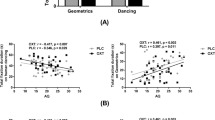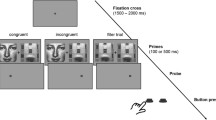Abstract
Background
Perceiving accurately that others are looking away from us (averted gaze) is as important, for social interactions, as perceiving that others are looking at us (direct gaze). However, previous studies have revealed that when the deflection angle of averted gaze is small, individuals tend to falsely perceive it as direct gaze. Oxytocin (OXT) has been shown to increase orientation to the eye region. Therefore, a critical question is whether and how OXT would facilitate the perception of ambiguous averted gaze.
Objectives
The present study aimed to measure the effects of OXT on the performance of males and females in distinguishing ambiguous averted gaze from direct gaze of different emotional faces.
Methods
In a double-blind placebo-controlled crossover experiment, 48 participants were presented successively two emotional faces with direct gaze (defined as 0, indicating the center of the eye) or averted gaze (defined as ±4, indicating the corner of the eye; +4 means that the iris moves 4 steps to the right; and −4 means that the iris moves 4 steps to the left) following intranasal oxytocin or placebo treatment and asked to make judgments on whether or not the two faces were the same in terms of identity. The interference effect of gaze direction was calculated by subtracting the mean accuracy and reaction time in the congruent gaze condition from those in the incongruent gaze condition. The logic of the measurement was if intranasal OXT would facilitate the detection of ambiguous averted gaze, we would observe a larger interference effect in the gaze incongruent condition compared with the gaze congruent condition, leading to longer RT or/and lower accuracy for identification judgment in the gaze incongruent condition.
Results
While there were no OXT effects in accuracy, we found a significant interaction between treatment, sex, and gaze congruency in reaction times. That is, following OXT as compared to placebo, women displayed stronger interference of gaze direction, whereas in men no significant difference was observed. Besides, this interaction did not vary across different emotional expressions.
Conclusions
Our findings provide the first evidence for sex-dependent effects of OXT on the perception of ambiguous averted gaze. Given potential therapeutic applications of OXT to patients with developmental and psychiatric disorders, who are characterized as atypical in encoding gaze features, the findings suggest that rather different treatment outcomes could be anticipated in males and females.



Similar content being viewed by others
References
Adams RB, Kleck RE (2003) Perceived gaze direction and the processing of facial displays of emotion. Psychol Sci 14(6):644–647
Adams RB, Kleck RE (2005) Effects of direct and averted gaze on the perception of facially communicated emotion. Emotion 5(1):3–11. https://doi.org/10.1037/1528-3542.5.1.3
Auyeung B, Lombardo MV, Heinrichs M, Chakrabarti B, Sule A, Deakin JB et al (2015) Oxytocin increases eye contact during a real-time, naturalistic social interaction in males with and without autism. Transl Psychiatry 5(2):e507
Baron-Cohen S, Cross P (1992) Reading the eyes: evidence for the role of perception in the development of a theory of mind. Mind Lang 7(1-2):172–186
Beck AT, Steer RA, Ball R, Ranieri W (1996) Comparison of Beck Depression Inventories -IA and -II in psychiatric outpatients. J Pers Assess 67(3):588–597. https://doi.org/10.1207/s15327752jpa6703_13
Boyarskaya E, Sebastian A, Bauermann T, Hecht H, Tüscher O (2015) The Mona Lisa effect: neural correlates of centered and off-centered gaze. Hum Brain Mapp 36(2):619–632
Cremers HR, Wager TD, Yarkoni T (2017) The relation between statistical power and inference in fMRI. PLoS One 12(11):e0184923. https://doi.org/10.1371/journal.pone.0184923
Di Simplicio M, Massey-Chase R, Cowen P, Harmer C (2009) Oxytocin enhances processing of positive versus negative emotional information in healthy male volunteers. J Psychopharmacol 23(3):241–248
Domes G, Heinrichs M, Glascher J, Buchel C, Braus DF, Herpertz SC (2007a) Oxytocin attenuates amygdala responses to emotional faces regardless of valence. Biol Psychiatry 62(10):1187–1190. https://doi.org/10.1016/j.biopsych.2007.03.025
Domes G, Heinrichs M, Michel A, Berger C, Herpertz SC (2007b) Oxytocin improves “mind-reading” in humans. Biol Psychiatry 61(6):731–733. https://doi.org/10.1016/j.biopsych.2006.07.015
Domes G, Lischke A, Berger C, Grossmann A, Hauenstein K, Heinrichs M, Herpertz SC (2010) Effects of intranasal oxytocin on emotional face processing in women. Psychoneuroendocrinology 35(1):83–93. https://doi.org/10.1016/j.psyneuen.2009.06.016
Domes G, Steiner A, Porges SW, Heinrichs M (2013) Oxytocin differentially modulates eye gaze to naturalistic social signals of happiness and anger. Psychoneuroendocrinology 38(7):1198–1202. https://doi.org/10.1016/j.psyneuen.2012.10.002
Donaldson ZR, Young LJ (2008) Oxytocin, vasopressin, and the neurogenetics of sociality. Science 322(5903):900–904
Dratsch T, Schwartz C, Yanev K, Schilbach L, Vogeley K, Bente G (2013) Getting a grip on social gaze: control over others’ gaze helps gaze detection in high-functioning autism. J Autism Dev Disord 43(2):286–300. https://doi.org/10.1007/s10803-012-1569-x
Emery NJ (2000) The eyes have it: the neuroethology, function and evolution of social gaze. Neurosci Biobehav Rev 24(6):581–604
Ewbank MP, Jennings C, Calder AJ (2009) Why are you angry with me? Facial expressions of threat influence perception of gaze direction. J Vis 9(12):16–16
Farroni T, Massaccesi S, Pividori D, Johnson MH (2004) Gaze following in newborns. Infancy 5(1):39–60
Gamer M, Zurowski B, Büchel C (2010) Different amygdala subregions mediate valence-related and attentional effects of oxytocin in humans. Proc Natl Acad Sci 107(20):9400–9405. https://doi.org/10.1073/pnas.1000985107
Gao S, Becker B, Luo L, Geng Y, Zhao W, Yin Y, Hu J, Gao Z, Gong Q, Hurlemann R, Yao D, Kendrick KM (2016) Oxytocin, the peptide that bonds the sexes also divides them. Proc Natl Acad Sci U S A 113(27):7650–7654. https://doi.org/10.1073/pnas.1602620113
George N, Conty L (2008) Facing the gaze of others. Neurol Clin Neurophysiol 38(3):197–207
Groppe SE, Gossen A, Rademacher L, Hahn A, Westphal L, Gründer G, Spreckelmeyer KN (2013) Oxytocin influences processing of socially relevant cues in the ventral tegmental area of the human brain. Biol Psychiatry 74(3):172–179. https://doi.org/10.1016/j.biopsych.2012.12.023
Guastella AJ, Mitchell PB, Frosso M (2008) Oxytocin enhances the encoding of positive social memories in humans. Biol Psychiatry 64(3):256–258
Harbort J, Witthoft M, Spiegel J, Nick K, Hecht H (2013) The widening of the gaze cone in patients with social anxiety disorder and its normalization after CBT. Behav Res Ther 51(7):359–367. https://doi.org/10.1016/j.brat.2013.03.009
Harbort J, Spiegel J, Witthoft M, Hecht H (2017) The effects of social pressure and emotional expression on the cone of gaze in patients with social anxiety disorder. J Behav Ther Exp Psychiatry 55:16–24. https://doi.org/10.1016/j.jbtep.2016.11.004
Heinrichs M, Baumgartner T, Kirschbaum C, Ehlert U (2003) Social support and oxytocin interact to suppress cortisol and subjective responses to psychosocial stress. Biol Psychiatry 54(12):1389–1398
Hietanen JK, Leppanen JM, Peltola MJ, Linna-Aho K, Ruuhiala HJ (2008) Seeing direct and averted gaze activates the approach-avoidance motivational brain systems. Neuropsychologia 46(9):2423–2430. https://doi.org/10.1016/j.neuropsychologia.2008.02.029
Hoge EA, Anderson E, Lawson EA, Bui E, Fischer LE, Khadge SD, Barrett LF, Simon NM (2014) Gender moderates the effect of oxytocin on social judgments. Human Psychopharmacology: Clinical and Experimental 29(3):299–304
Kanat M, Heinrichs M, Schwarzwald R, Domes G (2015) Oxytocin attenuates neural reactivity to masked threat cues from the eyes. Neuropsychopharmacology 40(2):287–295
Lobmaier JS, Tiddeman BP, Perrett DI (2008) Emotional expression modulates perceived gaze direction. Emotion 8(4):573–577. https://doi.org/10.1037/1528-3542.8.4.573
Martins DA, Mazibuko N, Zelaya F, Vasilakopoulou S, Loveridge J, Oates A, Maltezos S, Mehta M, Wastling S, Howard M, McAlonan G, Murphy D, Williams SCR, Fotopoulou A, Schuschnig U, Paloyelis Y (2020) Effects of route of administration on oxytocin-induced changes in regional cerebral blood flow in humans. Nat Commun 11(1):1160. https://doi.org/10.1038/s41467-020-14845-5
Oliva JL, Rault J-L, Appleton B, Lill A (2015) Oxytocin enhances the appropriate use of human social cues by the domestic dog (Canis familiaris) in an object choice task. Anim Cogn 18(3):767–775. https://doi.org/10.1007/s10071-015-0843-7
Putnam P, Roman J, Zimmerman P, Gothard K (2016) Oxytocin enhances gaze-following responses to videos of natural social behavior in adult male rhesus monkeys. Psychoneuroendocrinology 72:47–53
Rhodes G, Addison B, Jeffery L, Ewbank M, Calder AJ (2012) Facial expressions of threat influence perceived gaze direction in 8 year-olds. PLoS One 7(11):e49317. https://doi.org/10.1371/journal.pone.0049317
Riem MM, Bakermans-Kranenburg MJ, Voorthuis A, van IJzendoorn, M. H. (2014) Oxytocin effects on mind-reading are moderated by experiences of maternal love withdrawal: an fMRI study. Prog Neuro-Psychopharmacol Biol Psychiatry 51:105–112
Righi S, Marzi T, Toscani M, Baldassi S, Ottonello S, Viggiano M (2012) Fearful expressions enhance recognition memory: electrophysiological evidence. Acta Psychol 139(1):7–18
Rilling JK, Demarco AC, Hackett PD, Chen X, Gautam P, Stair S et al (2014) Sex differences in the neural and behavioral response to intranasal oxytocin and vasopressin during human social interaction. Psychoneuroendocrinology 39:237–248. https://doi.org/10.1016/j.psyneuen.2013.09.022
Schulze L, Lischke A, Greif J, Herpertz SC, Heinrichs M, Domes G (2011) Oxytocin increases recognition of masked emotional faces. Psychoneuroendocrinology 36(9):1378–1382
Senju A, Johnson MH (2009) The eye contact effect: mechanisms and development. Trends Cogn Sci 13(3):127–134
Shahrestani S, Kemp AH, Guastella AJ (2013) The impact of a single administration of intranasal oxytocin on the recognition of basic emotions in humans: a meta-analysis. Neuropsychopharmacology 38(10):1929–1936
Shi Y, Liu J, Hu Z, Gao S (2020) Opposing sex-dependent effects of oxytocin on the perception of gaze direction. Psychopharmacology 237(3):869–876. https://doi.org/10.1007/s00213-019-05423-9
Simpson EA, Paukner A, Sclafani V, Kaburu SS, Suomi SJ, Ferrari PF (2017) Acute oxytocin improves memory and gaze following in male but not female nursery-reared infant macaques. Psychopharmacology 234(3):497–506
Spielberger CD (1983) Manual for the State-Trait Anxiety Inventory (Form Y). Consultant Psychologists Press, Palo Alto
Straube T, Langohr B, Schmidt S, Mentzel HJ, Miltner WHR (2010) Increased amygdala activation to averted versus direct gaze in humans is independent of valence of facial expression. Neuroimage 49(3):2680–2686
Tanaka JW, Sung A (2016) The “eye avoidance” hypothesis of autism face processing. J Autism Dev Disord 46(5):1538–1552
Tollenaar MS, Chatzimanoli M, van der Wee NJ, Putman P (2013) Enhanced orienting of attention in response to emotional gaze cues after oxytocin administration in healthy young men. Psychoneuroendocrinology 38(9):1797–1802
Wastler HM, Lenzenweger MF (2018) Cone of gaze in positive schizotypy: relationship to referential thinking and social functioning. Personal Disord 9(4):324–332. https://doi.org/10.1037/per0000258
Watson D, Clark LA, Tellegen A (1988) Development and validation of brief measures of positive and negative affect: the PANAS scales. J Pers Soc Psychol 54(6):1063–1070. https://doi.org/10.1037//0022-3514.54.6.1063
Yao S, Zhao W, Cheng R, Geng Y, Luo L, Kendrick KM (2014) Oxytocin makes females, but not males, less forgiving following betrayal of trust. Int J Neuropsychopharmacol 17(11):1785–1792
Yue T, Yue C, Liu G, Huang X (2018) Effects of oxytocin on facial expression and identity working memory are found in females but not males. Front Neurosci 12:205
Acknowledgements
This work was supported by grants from the National Natural Science Foundation of China (grant number 31600883 to ZH, and 31600880 to SG) and Youth Science and Technology Star Project of Dalian (grant number 2017RQ140 to Z.H.).
Author information
Authors and Affiliations
Contributions
ZH conceived and designed the experiments. YZ and YS performed the experiments and analyzed the data. ZH and SG interpreted the results. YZ, ZH, YS, HJ, and SG wrote the manuscript. All authors revised and approved the manuscript.
Corresponding authors
Ethics declarations
Conflict of interest
The authors declare no competing interests.
Additional information
Publisher’s note
Springer Nature remains neutral with regard to jurisdictional claims in published maps and institutional affiliations.
Rights and permissions
About this article
Cite this article
Zheng, Y., Shi, Y., Jia, H. et al. Intranasal oxytocin enhances the perception of ambiguous averted gaze in women but not in men. Psychopharmacology 238, 2021–2029 (2021). https://doi.org/10.1007/s00213-021-05828-5
Received:
Accepted:
Published:
Issue Date:
DOI: https://doi.org/10.1007/s00213-021-05828-5




